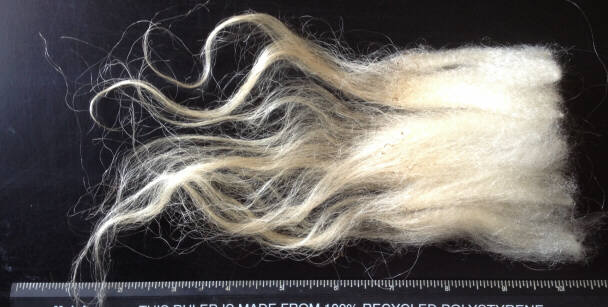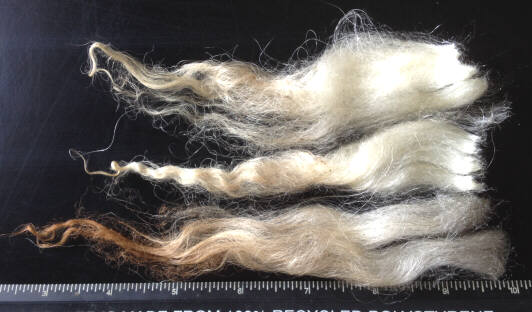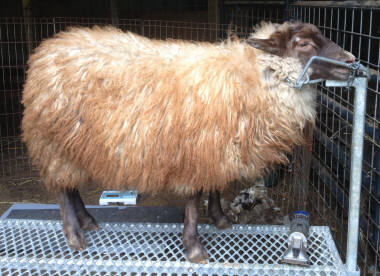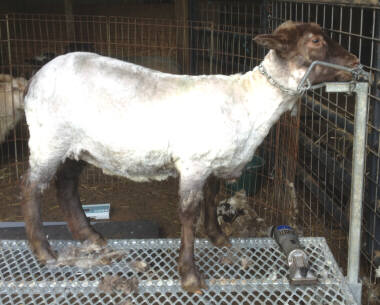
About Icelandic fiber Lamb Site map
* * * * * * * * * * * * * * * * * * * *
About Icelandic fiber
Icelandic sheep are double-coated. They have a soft, fine under coat called thel, and a longer, coarser outer coat called tog.

These fibers can be processed and spun together, with the tog giving strength and weather-resistance, and the thel adding loft, softness and warmth. Longer staples can be used to make a softly spun singles yarn, in the style of the well known Icelandic 'lopi' yarn, used for warm and beautiful Icelandic wool sweaters. The tog and thel can also be used separately, with the tog suitable for warp, rugs, and crafting, and the soft thel used for items to be worn next to the skin, or fine yarn for socks or lacy shawls.
Icelandic lamb fleeces are generally softer than adult fleeces, and the difference between the tog and thel is not as pronounced. The thel has a wavy, irregular crimp, and the tog is usually somewhat corkscrewed.

The length of Icelandic wool varies, depending on when the sheep are sheared, and what part of their body it comes from. Icelandic sheep can grow over an inch of wool per month. Lambs sheared at four months old will have fleece averaging 5 to 6 inches over much of their body. The bottom lock in the above picture came from this moorit grey lamb, sheared at 3 months and 3 weeks of age:


Icelandic sheep come in a variety of colors and patterns. The basic colors are white, black, and moorit (brown), although genetically white is a pattern and/or due to white spotting. The undercoat may be the same color as the outercoat, making the colored areas solid black or solid moorit. The undercoat may also come in white or cream, making black areas appear grey, and moorit areas lighter brown (also termed 'moorit grey'). Two other patterns are badgerface and mouflon. All of these patterns and colors can have either a little or a lot of white spotting, making for a very colorful flock!
Icelandic fleece is 'open', which means it's a lot less dense than many wool breeds. In exchange for density, you get more length. This openness also means that some of the vegetable matter that gets into the coat will fall out on its own. Icelandics also have less lanolin than many wool breeds, so less weight is lost in washing. A lower lanolin content also means that generally, less dirt and dust is attracted and held in the coat.
Working with Icelandic fiber:
Icelandic wool offers many possibilities from one fleece! You can spin from the locks, use hand cards or a drum carder, or Viking combs. You can keep both under and outer coat together, or separate them. The multicolored fleeces can be carded to blend the colors, or you can spin the different colors and shades alternately, for a variegated effect. Icelandic wool is also great for felting projects. The following are some suggestions, but you can use any method that gives you the results you want.
Keep in mind that Icelandic is not necessarily the best choice for a beginning spinner. When you are new to spinning, a fiber with a consistent length is a great help. By its very nature, a double-coated fleece has a variety of lengths in the same fleece. You can sort the fleece into similar-sized locks; separate the two coats; or just dive right in and see how it works out. If you find it too challenging, you can try finding a local spinning guild for help; look for a teacher and take some lessons; put the fleece aside and come back to it later; or look online for videos on spinning Icelandic or double-coated fleeces.
Icelandic raw fleece is washed the same as any fleece. Be extremely careful to avoid agitation, as Icelandic fleece felts easily, especially the thel.
If you want to spin from the locks, you can use a flick carder or a dog 'slicker brush' to open the tips of the locks. Open the butt ends carefully by hand, as a flick carder may remove too much of the soft, fine thel. Then, spin from the butt ends, which will make it easier to draft roughly equal amounts of thel and tog as you spin.
You can also use hand cards or a drum carder, and keep the under and outer coats together. If the fibers are long enough (tog about 5 inches or longer), you can spin worsted or semi-worsted, and make a lightly spun singles yarn, Lopi-style. This softly spun singles takes advantage of the length of the fiber to hold it together, while retaining a lot of the loft and softness of the thel. The combined coats can also be spun woolen or semi-woolen, and plied. Be aware that spinning the yarn too tightly may make a prickly, harsh yarn due to the coarser tog.
The combined coats are excellent for warm winter outerwear, like sweaters, hats, mittens, coats and cloaks. You can also make accessory items, like purses and carry bags. A nice bulky yarn would make a soft, warm, plush rug.
The tog and thel can be separated several ways. By hand, hold the butt end of a lock in one hand, and grasp and pull the longer tog out of the lock with the other hand. With a flick carder or dog comb, hold a staple by the tog, as close to the thel as you can, and pull the carder or comb through the butt end of the staple, to pull the thel out. Or you can use Viking combs - the first (and longest) fiber you pull out will be the tog. Once you come to the finer thel, you can set the tog aside and then continue to pull the thel off the comb. Alternatively, once you have pulled the tog out, you can use hand cards for the thel.
The separated tog can be spun worsted or semi-worsted, and can be used for weaving and needlepoint thread. It can also make strong, hard-wearing rug yarn.
The separated thel is super soft, can be used for next-to-the skin wear, and is soft enough for baby clothes. It can also make a wonderful lace-weight yarn. Spin the thel woolen or semi-woolen to maximize the loft and softness.